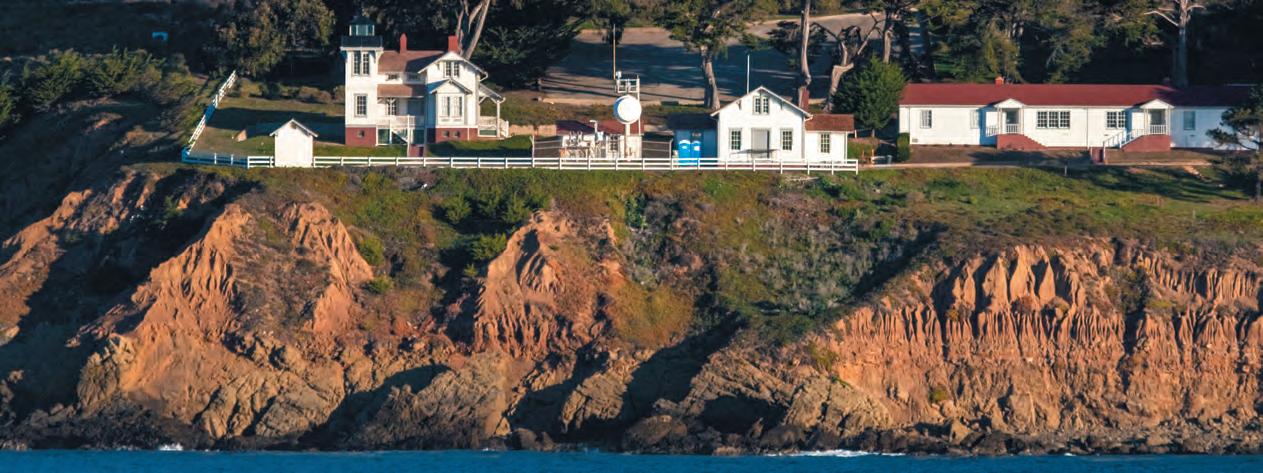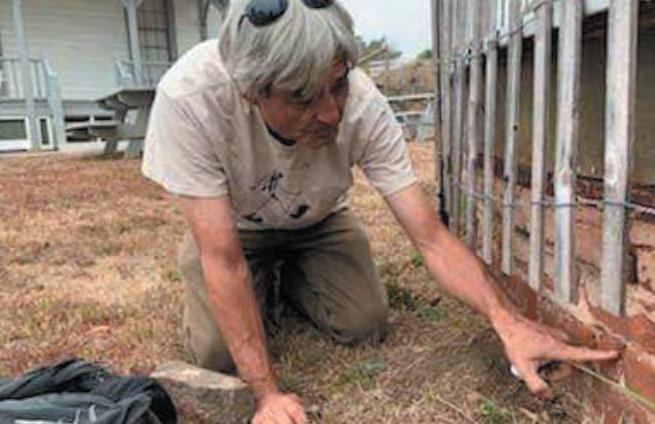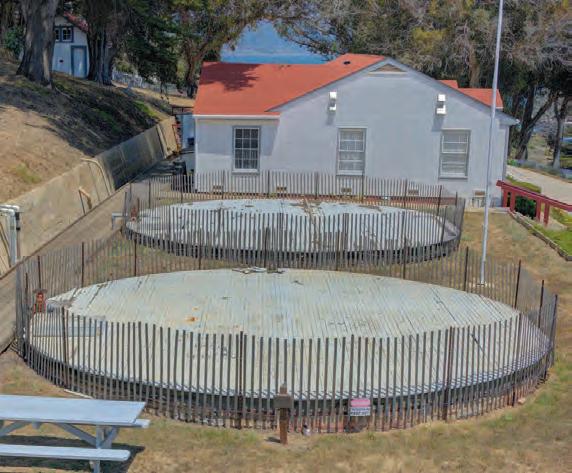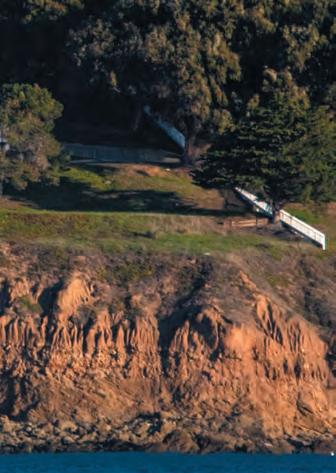
6 minute read
Preservation
POINT SAN LUIS CISTERNS:
In Need of a Makeover
by Kathy MastAko
Most of the light station has been beautifully restored thanks to a dedicated corps of volunteers, visionaries, and donors. But the restoration of the station’s cisterns remains an urgent need.
The cisterns are historically important: they date back to 1890 and stored the water needed to produce the steam for our original fog signal. Now their insides are unstable, and their covers have deteriorated so badly that they must be surrounded by security fencing—a real eyesore—for the safety of visitors. While water is no longer needed to operate a fog signal, it is vital for the station’s fire protection.
There can be no doubt that the cisterns must be saved.
But first, a little history…
Originally there were five cisterns at the site: three 10,000-gallon aboveground cisterns and two 50,000-gallon in-ground cisterns.
The above-ground cisterns were for household use; they were designed to capture rainwater runoff from the dwellings’ roofs. These cisterns no longer exist. The double-keeper’s dwelling and cisterns were demolished in 1960; the cistern originally placed on the west side of the keeper’s dwelling is long-gone and has not been rebuilt.
The two in-ground cisterns were built to hold water needed for the boilers in the fog signal building, as the first fog signal was a steam whistle.
According to the Lighthouse Board’s 1890 report:
“A separate contract was made for the duplicate fog signal set up in place…A space, within 100 feet of the signal, was cleared and cemented for a water-shed, and underground cisterns, with a capacity of 100,000 gallons, were built for the storage of water.”

Dan Mosier, a California brick expert, examines the cistern bricks in August 2019. His examination confirmed the bricks came from the Ah Louis brickyard in San Luis Obispo. Photo courtesy of the Point San Luis Light Station archives
The bricks used for the cisterns came from one of Ah Louis’s brickyards.
W. H. Heuer, the 12th district lighthouse engineer at the time, wrote to the Lighthouse Board in April 1980 that the five cisterns had a combined capacity of about 130,000 gallons. But Heuer was concerned about the lack of water. He wrote:
“I have caught from all available sources and now have on hand at this station about 30,000 gallons of water, and no prospects of getting any more from rainfall…before next November.
The quantity of water on hand is ample to supply the keepers and their families until next November but is far from sufficient to establish and maintain the steam fog signal. The nearest good water to the station is in a creek about 3-1/2 miles distant from the station. This water is excellent in quality and ample in quantity, and I estimate that I can lay a pipe and fill all our cisterns…in fact, procure an abundant supply for all the wants of the station by laying a pipe from the station to the creek...
As there is no wagon road to the station, water cannot be hauled there, and there is no practicable way of getting it there other than by piping it. The creek is on private land; the parties owning the creek also own the land between the creek and the lighthouse reservation. They will not object to laying a pipe on their land, but may want some compensation for permitting us to use the water, as well as for the use of the land on which the pipe may be laid. If the compensation which they ask should be reasonable and fair, I deem it proper that we should pay it…
Darrel Beerbohm, officer-in-charge from 1965 until 1967, recalled the pipeline from Pecho Creek leading to the cisterns that were next to his quarters:
“Water always seemed to be plentiful as the spring never dried up, and of course, we had the water tested often and chlorination systems to keep it safe. Just above the station, there was a large cement slab where at onetime rainwater was caught and drained into the cisterns, but this system was no longer in operation.”

Jay Conlin, who served at Point San Luis during 1971, recalled that water came to the light station through inch-and-a-half PVC pipe:

At all events, we must get water to run the fog signal and maintain it until the next rainy season sets in or else defer the establishment of the fog signal until the rains commence next November…I have a surplus of about $17,000 left from the appropriation for establishing this station, and if permitted to get the water in the way aboverecommended, I think our tanks can be filled within 15 days after the receipt of authority and that we can have an abundant supply of water thereafter as long as our pipe lasts without additional expense to the Government…”
“The water went into two large [cisterns] to the right of the keeper’s residence on the same level. We then pumped it up to the water tank on the hill behind the station. Once a month, the chief would send one of us up with a gallon of Photo courtesy of Michael L. Baird Point San Luis cisterns, urgently in need of restoration. Photo courtesy of Bob Mihelic bleach to pour into the tank for chlorination. Can you believe that? Climbing that old ladder and pouring it in after avoiding rattlesnakes on the climb up?” Which brings us to now… The restoration of the cisterns has been pending for several years due to lack of funding but has recently become a more pressing need because of climate change and the constant threat of a fire that could destroy this historic site.
(The creek Heuer wrote about was Pecho Creek.)
And some memories…
Those stationed at Point San Luis over the years remember the cisterns well.
Our remote location is only accessible by a one-lane, one-anda-half-mile steep, and winding road. In case of fire, the cisterns are our only source of water for fighting the blaze. The extreme fire danger was recently demonstrated by a controlled burn behind the lighthouse, which took off like a tinderbox even though brush was still damp from a recent rain. The controlled burn went off without a hitch. But what if it hadn’t?
Judy Moorefield, daughter of Keeper Bob Moorefield, recalled:
“The ground was rough, and I had a tricycle. It was a joy for me to ride my tricycle on the smooth wooden surface that covered the cistern but the possibility that it might break and plunge me into the water frightened my mother beyond words. What a spanking I received when my father caught me one time riding my tricycle at this forbidden location.”
Gail Settlemier Lay, daughter of Coast Guardsman Robin Settlemier, who was stationed there during 1959 and 1960, recalled that the cisterns were extremely off-limits. She and her siblings were told not to play near them, and certainly not to play on them. This was drilled into them. Gail recalled a time when her father had to measure the water level in one of the cisterns. With a tether attached, he walked onto the cistern cover, and two other guardsmen opened it up. Gail
Through the generosity of many donors and our ongoing fundraising efforts, we have accumulated $90,000 toward the cisterns’ restoration. But this falls short of our need. We need to raise an additional $230,000 in order to complete the project this year.
You can help us do this. You can donate online through our website www.pointsanluislighthouse.org, call 805-540-5771, or send a check to P.O. Box 308, Avila Beach, CA 93424, payable to the Point San Luis Lighthouse Keepers.
The light station has a proud 130-year history. Let’s not lose this history for lack of a way to protect it.









